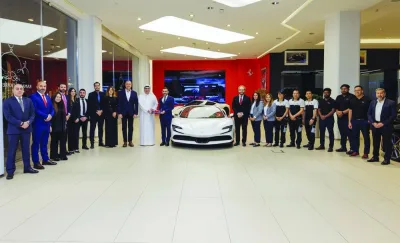Despite years of speculation it still came as a bombshell when the news filtered through that Lewis Hamilton would be switching from Mercedes at the end of the coming season to drive for Ferrari, that most iconic of racing stables. Hamilton said that he was “excited” and that the “time was right” for a move but the question remains whether his gamble, announced on Thursday, will pay off on the track. It is a move that echoes his decision to jump from McLaren, where he had won the 2008 drivers’ title, before the 2013 season. “This is unreal! Biggest driver move shock since...Lewis left McLaren for Mercedes!” tweeted pundit and racing driver Karun Chandhok on X.
Like McLaren in 2012, Mercedes has dropped behind a dominant Red Bull team. Even though 12 years ago Hamilton was switching between teams that were both much slower than Red Bull, he made the right decision as he collected six more world titles. But he was 28 when he first drove for Mercedes: he will be 40 when he takes his Ferrari seat. Maybe he has seen something that has convinced him that he has a better chance of breaking the tie for most driver titles with Michael Schumacher, who won five of his seven with Ferrari. But there were reportedly tensions with Mercedes over his contract. In 2013, his first season at Mercedes, Hamilton finished a distant fourth as Sebastian Vettel won a fourth straight title.
The following season, Hamilton won the title and went on to take five of the next six, missing out only in 2016 when team-mate Nico Rosberg edged him by five points. Rosberg promptly retired, aged 31.
The pendulum swung back to Red Bull in 2021 when Max Verstappen took the title by just eight points after a bitterly controversial season-ending Abu Dhabi Grand Prix. Since then the gap between Verstappen and Hamilton has widened. It was 215 points in 2022, when Hamilton finished the season sixth, and 341 points last season. Ferrari could not keep pace with Red Bull either. While Hamilton climbed from sixth in 2022 to third overall last season, Ferrari’s star Charles Leclerc went the other way, dropping from second to fifth. The Italian team’s only real cheer in 2023 came when Carlos Sainz, the man who will make way for Hamilton, won in Singapore. In a sport of large egos, Hamilton and Leclerc will have to find a way to work together.
The long-bubbling speculation linking Hamilton to the team of Schumacher, Alain Prost, Niki Lauda and Juan Manuel Fangio, exploded at the Monaco Grand Prix last May. Sitting alongside Hamilton at a press conference, Leclerc was asked what he looked for in a team-mate. He giggled and glanced across at the Briton. “Hello Lewis,” he said. “I mean, a fast teammate, like everybody. We are in Formula 1, and we love to be fighting against the best. I think anybody on the grid will love to have Lewis as a teammate, as everybody will learn a lot from him.”
Pride, as well as the need to be competitive, seems to have played a role in Hamilton’s decision. Hamilton reportedly has long been friendly with John Elkann, the chairman of the multinational Stellantis and also of its subsidiary Ferrari, but had repeatedly turned down offers to join the Scuderia. Hamilton, who last season talked of retiring, had asked Mercedes to be made a global ambassador. The team declined, signing him instead to a two-year contract, with the second season optional. Meanwhile, Ferrari were having problems negotiating with Sainz, who was the only man not driving a Red Bull to win a Grand Prix last season. The industry press was filled with wildly varying speculation over Hamilton’s likely Ferrari salary. He may earn more than the top-paid driver, Verstappen, or he might be taking a pay cut. There may also be some type of long-term promise - perhaps the ambassadorial role he was looking for at Mercedes - that would allow Ferrari to cash in on Formula One’s biggest global star in return for support for his diversity and inclusion projects such as his Mission 44.

This combination of file pictures shows Mercedes' British driver Lewis Hamilton and the logo of Team Ferrari. (AFP)


